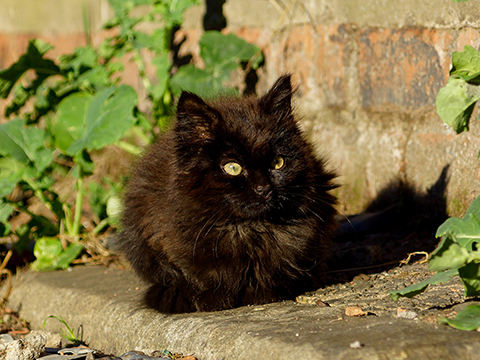By GSWA Volunteer, Jim Northrop
People seem to have strong feelings about whether to own a dog or a cat as a pet. While I was growing up, my parents always had a pet dog, so I thought that must be the norm. They never would have considered bringing home a pet cat. But several summers ago, my youngest daughter brought home a sweet little kitten from a neighbor cat’s litter, and begged for us to keep it. How could I say “No”?
That started a surprising new learning experience for me. For starters, I learned that the domestic cat is part of a huge worldwide family, which includes the jaguar, leopard, lion, ocelot and the puma, as well as a genus Lynx, which includes the Canada lynx and the bobcat.
I did not know that the common pet cat probably was originally a native of Egypt. It was an object of worship and was frequently mummified. However, apparently it was not known to the ancient Greeks and Romans, who used domesticated martens to destroy rats and mice.
From watching my daughter’s kitten, I learned that domestic cats are fastidious animals, constantly washing their fur and paws. Friends told me that I should be prepared to be “adopted” by this cat, and all that implies about who is the “boss”,
when she became an adult. That, whereas dogs usually are eager for you to adopt them, it is the reverse with cats. It was interesting to see how the introduction of “cat psychology” into our day-to-day family life, worked out.
Well, that kitten of my daughter’s grew into an adult domestic cat, and we loved having her. But, one day, another cat began regular appearances in our back yard. She was a pretty cat, so before long my kids wanted to adopt her (or him), too.
But, I had some questions, and so I consulted with our veterinarian. He explained that this new cat could be:
(1.) a cat that has an owner but is allowed to roam outside unsupervised, OR
(2.) a cat that was formerly owned, but has been abandoned or lost, OR
(3.) a feral cat, one that is the wild-born offspring of a free-roaming or other
feral cat.
Feral cats, he said, are not socialized and are not suitable pets, as they are often too fearful of people to ever be touched or domesticated. While it is possible for lost strays or abandoned free-roaming cats to be reunited with their families or adopted into new homes, feral cats (because of their lack of early socialization), are generally not able to adapt to living indoors in close contact with people. Feral kittens, he said, depending on their age, may be young enough to tame.
My vet also pointed out that cats which are permitted to roam outdoors unsupervised can have a negative effect on local wildlife populations. As natural predators, even the common house cat can do an incredibly effective job killing local birds, rodents and reptiles. This can cause serious environmental problems, especially if there are endangered species present.
Furthermore, he said, any unsterilized cats permitted to roam outdoors will almost certainly produce litters of kittens, contributing to the outdoor cat over-population problem. He went on to say that left unattended, feral cats can breed unchecked to the point of exhaustion, malnutrition and disease. Sadly, he concluded, suffering and pain can become daily realities for individual feral cats.
When my wife heard of this discussion, she remembered that a local not-for-profit was offering something called “T-N-R”. She said this method of feral cat control involved trapping the feral cat, vaccinating, spaying or neutering, and then returning the feral cat back to its former environment. There, a volunteer “caretaker” would monitor, feed and shelter the cat. She said experience had shown the benefits of T-N-R over the old fashioned approach of trapping the feral cat and just killing it. When that method of feral cat control was used, the death of the cat created a territorial “vacuum,” rapidly filled by other neighborhood cats, who simply moved in, continued to procreate, and thus continued the trend of feral cat over-population. If there was thought to be a “cat nuisance,” it was not diminished simply by the killing of that first cat.
What do “spay” and “neuter” mean? They are terms used for sterilizing cats. Female cats are spayed by removing their reproductive organs. Male cats are neutered or castrated. Both surgeries require general anesthetic and are performed by a veterinarian.
So, what should we do for our new cat “friend”? There was much family discussion. We asked neighbors if this newly arrived cat already had a home, but we received no helpful information. We examined the cat for a collar or an inserted micro-chip, but found none. It was agreed that we would arrange for the T-N-R procedure, even though we were not sure this was truly a feral cat. As a family, we agreed to be the “caretaker” thereafter for this cat. My kids were delighted. The cat remained an outdoor cat (except that in winter, the cat had “privileges” in our garage). We would feed daily our newly found cat, in the same feeding location, and in the summers enjoyed its company. Eventually, we were even able to entice it to enjoy with us our deck on warm, sunny days. You see, some trust had been developed between us and this cat.
Oh, one correction —– we did not adopt this cat, she adopted us!

